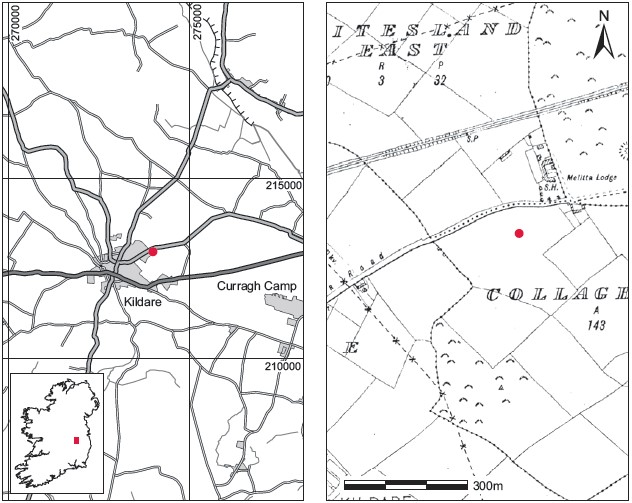County: Kildare Site name: COLLAGHKNOCK GLEBE, CO. KILDARE,
Sites and Monuments Record No.: SMR KD0722-037 Licence number: E1080
Author: BREANDÁN Ó RÍORDÁIN
Site type: Graves of indeterminate date
Period/Dating: —
ITM: E 673934m, N 713002m
Latitude, Longitude (decimal degrees): 53.162371, -6.894386
Introduction
In September 1966 human remains were discovered during digging for sand at a stud farm near Kildare town, Co. Kildare. The bones lay at a depth of approximately 0.55m below ground level. They were removed from the ground by the workmen and placed on the grass surface nearby. The find was reported to the Garda Síochána in Kildare that day and they reported the find to the NMI. The following day it was investigated by Breandán Ó Ríordáin. The human remains from the site were examined by Professor C.A. Erskine. This report is based on Ó Ríordáin’s site report and Erskine’s analysis of the bone.

Location (Fig. 6.14)
The site was in the townland of Collaghknock Glebe in west County Kildare, just 1km northeast of Kildare town.20 It lay in a natural sand deposit, approximately 15m north/south by 20m east/west, between c. 90m and 120m above sea level. The site occupied the western part of a large paddock on a stud farm. In 1944 an earthwork was excavated by Seán P. Ó Ríordáin about 0.5km from here in the townland of Curragh.
Description of site
At the time of investigation there was no visible grave structure. It is likely that the burial was in a simple unprotected grave, as no stones or slabs were found in the vicinity. The burial had been deposited on a natural stratum of fine sand.
The grave contained the unburnt remains of one adult female (1966:120), and no accompanying artefacts were found. The workmen who found the bones could not recall whether the skeleton had been in an extended or crouched position. Further excavation around the find-spot revealed part of the skull. From its position Ó Ríordáin interpreted the body as having been aligned south-west/north-east, with the skull at the south-west.21 Further excavation was conducted in the vicinity but no further remains were noted.
Comment
Owing to the circumstances of discovery and the limited nature of the investigation it is not possible to suggest a date for this burial.
HUMAN REMAINS
C. A. ERSKINE
1966:120—fairly complete skeleton of one adult female, not cremated. Few rib fragments or vertebrae present. Fragments of scapulae and small light clavicles. Long bones well preserved. Humeri symmetrical and with unusually deep spiral grooves in middle of both bones. Both bones fairly small.
Skull
Nearly complete vault present. Unusually narrow and vertical frontal bone. Right temporal and parietal have a piece 10cm by 10cm broken out (post-mortem damage). Bone thin. Dolicocephalic. Well-preserved mandible, nearly complete dentition, with then separate teeth having marked wear. Whole bone small and delicate.
Pelvis
Parts of both innominate bones present—marked female characteristics. Complete atlas and axis—noticeably small and light.
20. Parish of Kildare, barony of Offaly East. SMR KD0722-037——. IGR 274000 212971.
21. The workmen had found the teeth and lower jawbone of the burial in the course of the sand-digging